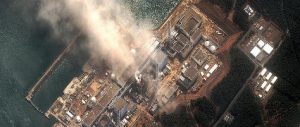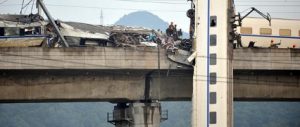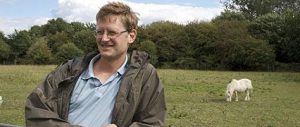A thin green ribbon threads its way across the Korean Peninsula. Viewed from space, via composite satellite images, the winding swath clearly demarcates the political boundary between the Republic of Korea (ROK) and the Democratic People’s Republic of Korea (DPRK). Its visual impact is especially strong in the west, where it separates the gray, concrete sprawl of Seoul from the brown, deforested wastes south of Kaesong. In the east, it merges with the greener landscapes of the Taebaek Mountain Range and all but disappears.
From the ground, the narrow verdant band manifests as an impenetrable barrier of overgrown vegetation enclosed by layers of fences topped by menacing concertina wire and dotted with observation posts manned by heavily armed soldiers. That a place so steeped in violence still teems with life seems unimaginable. And yet, the Demilitarized Zone, or DMZ, is home to thousands of species that are extinct or endangered elsewhere on the peninsula. It is the last haven for many of these plants and animals and the centre of attention for those intent on preserving Korea’s rich ecological heritage.
Once known as the “land of embroidered rivers and mountains”, the Korean Peninsula has experienced almost continual conflict for over 100 years, resulting in a severely degraded natural environment. International competition for control over the peninsula’s resources left Korea in a precarious position at the start of the twentieth century. The Japanese occupation between 1905 and 1945 brought with it radically increased exploitation of mineral and other resources, resulting in massive deforestation, pollution and general environmental decline.
Since at least the 1940s, deforestation for fuel wood and clearing for agricultural land has caused significant erosion of the area’s mountains and hills and contributed to the siltation of its rivers, streams and lakes. The 1950 to 1953 war ranged across the entire peninsula, subjecting it to widespread devastation that destroyed cities, roads, forests and even mountains. And, in the 1960s and 1970s, unchecked industrialisation further undermined the peninsula’s ecological health, causing air, water, and soil pollution.
The relative health of the DMZ now stands in stark contrast to the failing ecosystems in both North and South Korea.
Created in 1953 during tense armistice negotiations, Korea’s DMZ is at once one of the most dangerous places on earth and one of the safest. For humans, its thousands of landmines and the millions of soldiers arrayed along its edges pose an imminent threat. But the same forces that prevent humans from moving within the nearly 400 square miles of the DMZ encourage other species to thrive. Manchurian or red-crowned cranes and white-naped cranes are among the DMZ’s most famous and visible denizens. Nearly 100 species of fish, perhaps 45 types of amphibians and reptiles and over 1,000 different insect species are also supposed to exist in the protected zone.
Scientists estimate that over 1,600 types of vascular plants and more than 300 species of mushrooms, fungi and lichen are thriving in the DMZ. Mammals such as the rare Amur goral, Asiatic black bear, musk deer and spotted seal inhabit the DMZ’s land and marine ecosystems. There are even reports of tigers, believed extinct on the peninsula since before Japanese occupation, roaming the DMZ’s mountains.
Much of the biodiversity in the DMZ is speculative, extrapolated from spotty scientific studies conducted in the Civilian Control Zone (CCZ) that forms an additional protective barrier along the DMZ’s southern edge. Approximate though these studies are, the DMZ’s ecological promise is great enough to spur many people to action.
The simmering tensions on the Korean Peninsula over the past 60 years have at times reached a boiling point – from the 1974 discovery of several military incursion tunnels running under the DMZ from North Korea to the 2010 shelling of Yeonpyeong Island – putting the fate of the DMZ and its biodiversity into question. Efforts to protect the DMZ’s ecological and cultural offerings have become imperative.
One potential development on the minds of many Koreans is the return of a single Korean nation. A unified Korea would obviate the need for the DMZ and potentially imperil the existence of the various ecosystems the dividing line presently supports.
Many individuals, both on and off the peninsula, hope to preempt the destruction of the DMZ’s ecological treasury, should Korea reunify, by establishing a permanently protected area commensurate with the current DMZ boundaries. Solutions already proffered include the creation of a series of dedicated conservation areas in and along the DMZ, the development of ecotourism and educational zones and attaining World Heritage Site designation through UNESCO.
Two projects have already proven highly successful: the establishment of crane conservation areas in the DMZ along the Han River estuary and in the Anbyon Plain north of the DMZ near Wonsan, DPRK. The former zone spans the western edge of the DMZ south to Seoul and serves as a safe winter resting area for over 1,000 white-naped cranes. The South Korean government designated the area a national monument in 1976, after scientific studies by George Archibald of the International Crane Foundation and Kim Hon Kyu of Ehwa Women’s University determined the region’s importance to the continued survival of the species.
The second conservation area, located in the Anbyon Plain, supplements the migratory wintering grounds for both white-naped and red-crowned cranes inside the DMZ in the Choelwon Basin and along the peninsula’s western coast. Since its inception in the 1990s, the Anbyon Plain project has been an international, cooperative effort, bringing in researchers from Korea University in Tokyo, the State Academy of Sciences in Pyongyang and Tokyo University.
By working in partnership with local farmers to restore riparian, grassland, and forest habitats, the project demonstrates that cranes and humans can thrive in cooperation. Thus far, the project has garnered approval from the North Korean government and has set the stage for scientists and farmers to create both ecologically and economically sustainable agricultural practices that benefit both cranes and people.
Ecotourism and eco-education are also making headway. South Korea’s official tourism site offers the opportunity to visit an area south of the DMZ that it calls the Peace-Life Zone. The guidebook for the tour incorporates extensive photographs highlighting the natural beauty of the region and advertises the DMZ as “a peaceful place” that “marks the last untouched cold war border in the world today.”
Marketing and propaganda aside, the tour is evidence of the ROK’s willingness to promote and support efforts to preserve the area’s ecological sustainability. Similarly, in early 2010, the Catholic University of Korea and SungKongHoe University developed a joint course for students called “Life and Peace of the DMZ”. The course examined the history of the Korean War, media representations of the DMZ and the sociology and ecology of the area.
Perhaps the most comprehensive plans involve efforts to permanently set aside the DMZ and adjacent areas as an ecological preserve and cultural site. Several international and Korean NGOs are involved in disseminating information, gathering public support, and working with government agencies on both sides of the divide to achieve official recognition of the DMZ’s importance both environmentally and historically and subsequent protection of the area as an international transboundary peace park.
Among the leading associations, and one of the first organised for the purpose, is the DMZ Forum, whose mission is “to support conservation of the unique biological and cultural resources of Korea’s Demilitarized Zone, transforming it from a symbol of war and separation to a place of peace among humans and between humans and nature.” The DMZ Forum holds annual conferences to educate the public about the history and ecological importance of the DMZ.
Its primary and long-term goal is to gain approval from both sides of the line to nominate the entire DMZ and its adjacent zones as a cultural and natural World Heritage Site. This transboundary park would incorporate marine ecosystems in the West Sea, the Han River estuary and its lowland plains, the high mountains of the Taebaek Mountain Range and the East Sea tidal areas, providing a nearly comprehensive representation of the peninsula’s ecological systems. Combined, the area would incorporate over 400 square miles of protected ecosystems.
If the DMZ has served to remind the Korean people and the world of the lasting legacy of ideological and military conflict, then it has also become a symbol for a new generation wanting to preserve a reinvigorated Korean ecology. The war was a human tragedy, but out of terrible loss may come the prospect for ecological health and mutual cooperation. Korea’s political past and its environmental future are inextricably linked. The DMZ has become a green ribbon of hope, representing Korea’s promise for a healthy, peaceful future.
Lisa Brady is associate professor of history at Boise State University.
This article first appeared in Solutions journal. It is edited and used here with permission.
Homepage image by Bret Saalwaechter


